ZimaBlade is an inexpensive low-profile board based on an Intel Celeron dual-core or quad-core processor and designed for server applications with a low-profile RJ45 Gigabit Ethernet port, two SATA connectors, and a PCIe slot, but not only as the board also comes with display interfaces such as mini DP and USB-C DisplayPort Alt. mode and a few USB ports.
It’s not IceWhale Technology’s first venture into portable server board as the company previously introduced the Zimaboard based on Intel Celeron Apollo Lake processors with many of the same features back in 2021. The new ZimaBlade offers more interfaces as well as a complete enclosure instead of just a large heatsink.
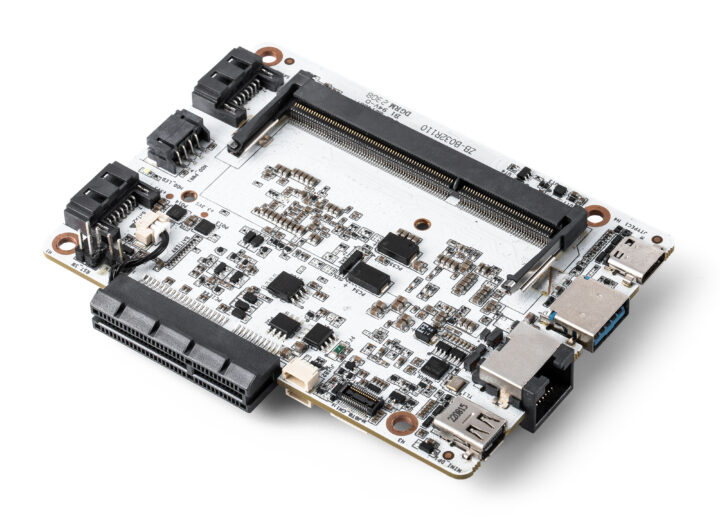
ZimaBlade specifications:
- SoC (one or the other)
- ZimaBlade 3760 – Intel Celeron dual-core processor up to 2.2 GHz (Turbo) with Intel UHD graphics; 6W TDP
- ZimaBlade 7700 – Intel Celeron quad-core processor up to 2.4 GHz (Turbo) with Intel UHD graphics; 10W TDP
- System Memory – Up to 16GB DDR3L memory via a single SODIMM slot
- Storage
- 32 GB eMMC flash
- 2x SATA 3.0 ports
- Display interfaces
- MiniDP port up to 4Kp60
- eDP connector
- DisplayPort via USB-C port
- Networking – Gigabit Ethernet RJ45 port
- USB – 1x USB 3.0 port, 2x USB 2.0 ports, 1x USB Type-C port for data, power, and display
- Expansion – PCIe 2.0 x4 connector
- Power Supply – 45 W USB Type-C power adapter
- Dimensions – 107 x 80 x 23 mm
- Weight – 175 grams
- Enclosure – Custom injection molded polycarbonate (opaque and transparent), aluminum alloy heatsink, and four black silicone feet
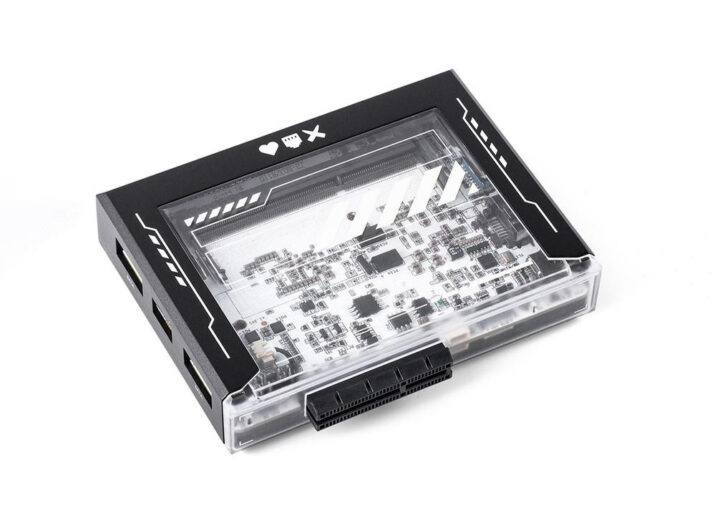
The ZimaBlade comes with the Debian-based CasaOS with “a streamlined Docker experience” with over 100,000 Docker apps to choose from (see GitHub repo for source), but as an x86 platform, it is also fully compatible with Windows, Ubuntu, Debian, Raspberry Pi OS, CentOS, OpenWrt, pfSense, Android, LibreELEC, and several other operating systems.
The ZimaBlade board can be used to create a personal NAS, a self-hosted AI server based on Auto-GPT open-source project, a media server, a retro-gaming console, and whatever you may think of. The company ran some benchmarks to compare it to a Raspberry Pi 4, and it’s about 2 to 4 times faster, or roughly equivalent to boards based on the Rockchip RK3588 SoC.
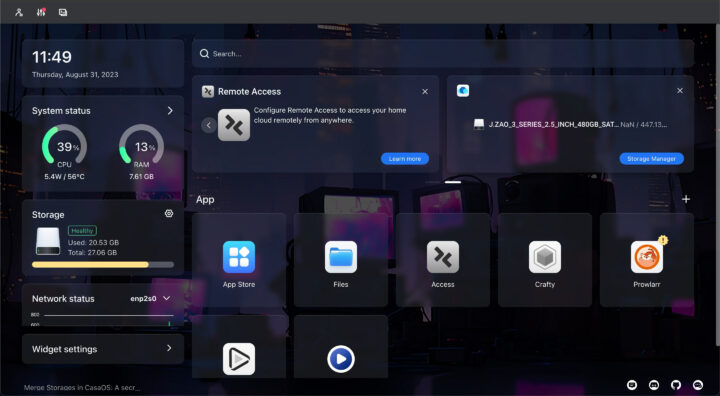
IceWhale Technology has just launched the ZimaBlade on Crowd Supply aiming to raise at least $50,000. Rewards start at $64 for the ZimaBlade 3760 Basic Kit with the board, the enclosure, a USB Type-C cable, and one SATA cable, while the ZimaBlade 7700 Basic Kit goes for $96, and you can get a ZimaBlade 12-Core 48 GB Cluster kit for $392 with three ZimaBlade 7700 boards, three 16 GB DDR3L memory sticks, three 12V/3A power adapters, three USB Type-C cables, three SATA cables and a dual 3.5-inch’ storage drive stand. Note the Basic kits require you to add your own RAM and power supply. Shipping adds $8 to the US and $18 to the rest of the world for the Basic kits, and deliveries are scheduled to start at the end of January 2024.

Jean-Luc started CNX Software in 2010 as a part-time endeavor, before quitting his job as a software engineering manager, and starting to write daily news, and reviews full time later in 2011.
Support CNX Software! Donate via cryptocurrencies, become a Patron on Patreon, or purchase goods on Amazon or Aliexpress


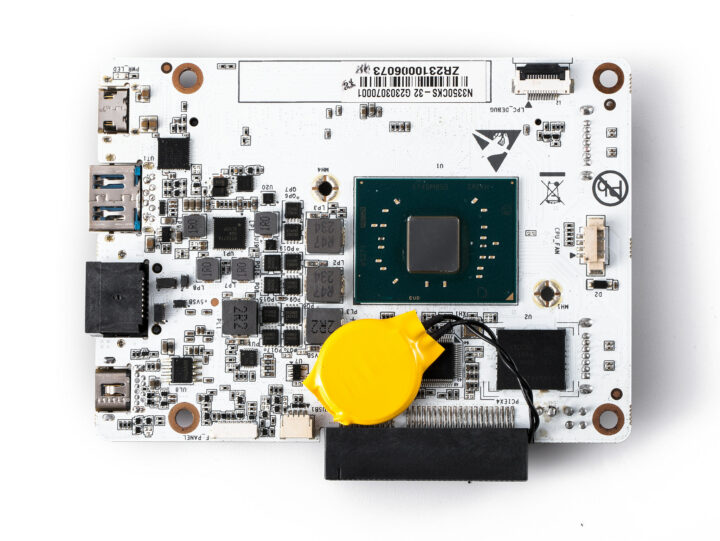
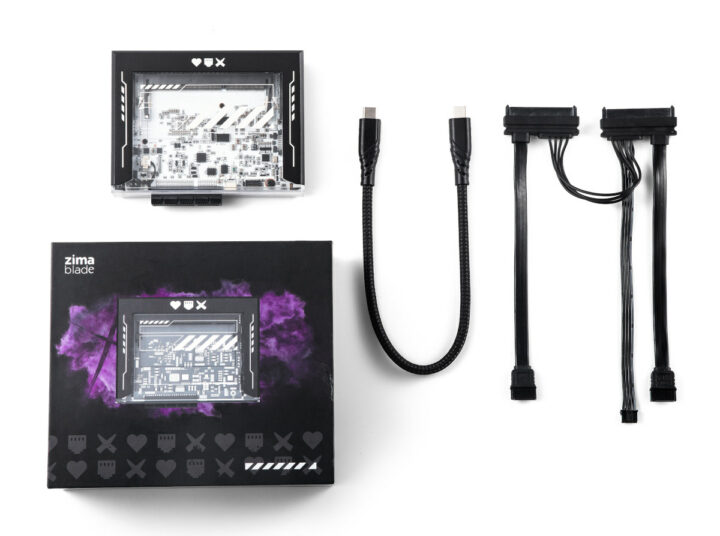



This definitely makes me think about a NAS barebone. It’s much richer in connectivity than many SBCs of the same price tag.
The SoCs are not specified clearly and I fear it is still some Apollo Lake CPU (DDR3L).
So you may have similar performance as the zimaboard of 2 years ago.
For those wanting a case, RAM and more storage, some cheap mini-machines between 120-150$ may be more interesting with more recent hardware for quite the same price at the end.
Googleing “SREKH” wich is visible on the cpu in the image it seems to be a Celeron N3350
I first thought they used the same processor as in the Zimaboard:
But they claim the dual-core is clocked up to 2.2 GHz, and the quad-core up to 2.4 GHz. It’s also possible they typed that wrong.
According to a spec table they sent me a few weeks ago, the ZimaBlade 3760 has a Celeron N3350 dual-core chip with turbo speeds up to 2.4 GHz, while the 7700 has “Intel Celeron E3950/J3455 quad-core” with speeds up to 2.3 GHz.
It sounds like maybe they hadn’t finalized the selection for the 7700 yet, and either there’s a typo for the top speeds for the 3760, or they switched processors.
> either there’s a typo for the top speeds for the 3760
There’s a bunch of contradicting writing on Crowdsupply and their own site. Affects TDP ratings and burst clocks of both CPU and GPU cores and nonsense like Geekbench 4 scores made maybe a century ago?
I asked them via email about specific SoCs used. They replied that 3760 model uses N3350 and 7700 model uses “N3450/J3455/E3940”.
Not sure what last one means. Maybe they got deal on last bits of stock for these chips as they are now past “End of Servicing Updates Date” listed on Intel site and mix of them will be used for quad core model.
If they gave it a 2.5gbps ethernet port it would be a more useful server or NAS.
A little bit confused. Why using apollo lake in 2023? Because they still have stocks that is not used up?
Given the price it’s very possible that they found an old inexpensive stock making it possible to sell acceptable hardware at a low price. Of course it’s not the latest design, but it’s likely more powerful than any similarly priced ARM SBC.
Old CPU or not, I do wonder what these J connectors or those around PCIe slot are for, perhaps this could be neatly integrated as a CPU board to be slotted onto a larger but simpler board to make new use cases?
All I really want is a faster CPU (dual core 3.5Ghz minimum), I don’t care if it consumes 35W, and a PCIe 3.0 x8 slot minimum (preferably a 4.0 x8 or 3.0 x16), 8GB of DDR4 3600Mhz, with an additional sodimm expansion slot.
And a PCIe 180° connector so the board would slide behind the GPU.
Gamers may want to see a mobile ryzen CPU in it instead.
and all that for 64 bucks…let’s be serious…
Go buy a mini/micro form factor then. You are looking at the wrong hardware here.
I have opinions.
The first zimaboard launched so quietly I didn’t realize it existed until a year later. They do say they sold 30k of them, and casa OS reviewed really well. This one seems virtually same except for some improved IO and a different design aesthetic, which is maybe more marketable.
The CPU is not disclosed, so either they don’t know yet or it’s the same batch as before.
8gb of ddr3l ram is included for only $8. The board price overall seems cheaper.
Putting the heat sink on the bottom this time is an interesting thermal choice.
I wonder where’s the eDP interface and what’s the connector/pinout